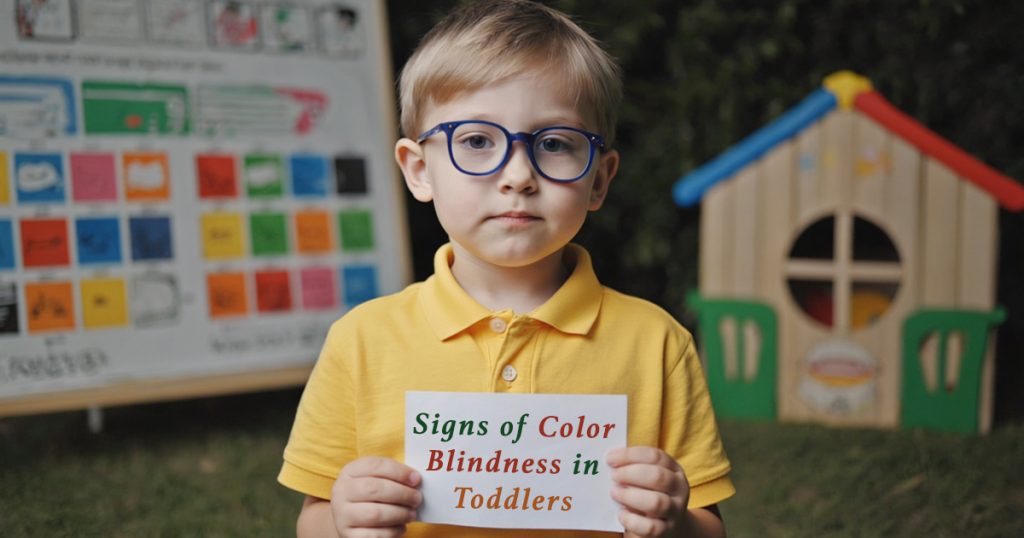Figuring out if your toddler is color blind can be surprisingly tricky. Kids under four are still learning their colors, so it’s natural for them to confuse a few here and there. But if you’re noticing consistent mix-ups or challenges, it might be worth a closer look. While 1 in 12 boys and 1 in 200 girls are born with some form of color blindness, many parents don’t catch it until later. Here’s how to spot the signs early, get a diagnosis, and make life easier for your little one.
What Is Color Blindness in Toddlers?
Color blindness, or color vision deficiency, is when someone has trouble telling certain colors apart. It happens because certain cells in the eye, called cones, don’t work properly. These cones help us see red, green, and blue. When they’re missing or not working as they should, things like red and green might look the same to someone who’s color blind.
Parents often ask, “Are babies color blind?” Technically, no—but newborns can only see high-contrast colors like black, white, and red. Their color vision improves over time, and by four to six months, they can see most colors. If your toddler struggles with colors well past this stage, it could be an early sign of color blindness.
Common Types of Color Blindness
Red-Green Color Blindness
This is the most common type. Kids with this condition might see red and green as the same or mix them up with shades of brown and orange.
Blue-Yellow Color Blindness
Far less common, this type makes it tricky to tell blue from green or yellow from red.
Total Color Blindness
Rare and extreme, this type leaves people seeing only shades of gray.
How to Spot Early Signs of Color Blindness
It’s not always obvious when young kids are color blind. After all, they might just be learning! But pay attention to patterns or repeat behaviors like these:
1. Confusing Colors Often
Does your child consistently call red “green” or mix up brown and orange? Sometimes, they might even say odd things like, “Everything looks green.”
2. Coloring in Unusual Ways
Look at their drawings. If they’re coloring the sky purple or grass orange repeatedly, it’s worth noting. While kids are creative, consistent “mistakes” could point to colorblindness.
3. Trouble with Sorting or Matching
Color-coded toys, games, or activities might stump them. A red-green color blind toddler could get frustrated when sorting blocks and mixing similar shades.
4. Sensitivity to Light
Some kids with color blindness squint more in bright light. This happens because their eyes process certain wavelengths differently.
5. Picking Out Clothes Is Hard
If your toddler can’t tell if their shirt matches their pants, they might be having trouble differentiating colors like blue and green or reds and purples.
How to Test for Color Blindness
Wondering what age you can test for color blindness? While a formal diagnosis is easier once they’re about 4 or older, there are fun and simple ways to start exploring their color vision at home.
Try a DIY Test at Home
Set up a small, casual activity with crayons or markers. Draw patches of common colors like red, green, orange, blue, and purple on paper in random order. Ask your child to name them or match them with objects around the house.
Pro Tip: Make it a game! Keep it fun and avoid putting too much pressure on them to “get it right.”
Visit an Eye Doctor
If you’re still concerned, schedule an appointment with an optometrist. Common tests include:
- Ishihara Test: This uses colored dot patterns with hidden shapes or numbers.
- Hue Sorting: Kids arrange color chips into gradients.
- Anomaloscope: A tool that tests how they perceive different light wavelengths.
Catching it early helps avoid struggles at school or in day-to-day tasks, making a real difference in how your child experiences the world.
Supporting a Color Blind Toddler
Okay, so your child is color blind. What now? The great news is, they can still thrive with a few small adjustments.
1. Make Everyday Life Easier
Label crayons and markers so they don’t have to memorize colors by sight. Use symbols or patterns (like stripes and polka dots) instead of just relying on colors in their games and schoolwork.
2. Team Up with Caregivers
Talk to teachers, babysitters, and anyone else who interacts with your child regularly. Making small changes, like avoiding color-coded instructions or using contrasting materials, can help a lot.
3. Use Technology or Tools
Some kids benefit from special glasses designed for color blindness. While they’re not a cure, they can enhance certain colors, making them easier to spot. You can also explore apps that identify colors in real time, which is super handy for activities like picking outfits.
4. Teach Alternative Skills
Kids with color blindness often learn to rely on other clues, like position or brightness. For example, on traffic lights, they might focus on where the light appears (top, middle, bottom) instead of its color.
5. Build Their Confidence
Remind your child that being color blind isn’t a flaw; it’s just a different way of seeing the world. Celebrate what makes them unique and encourage them to focus on their strengths.
If you’re curious about your toddler’s color vision, trust your instincts and keep things fun. Spotting color blindness early will help you give your child the tools they need to succeed. And remember, every child sees the world a little differently—that’s what makes them so special.
